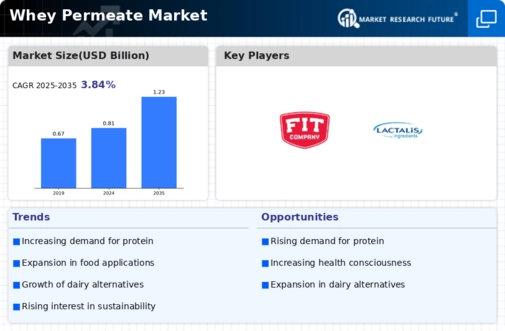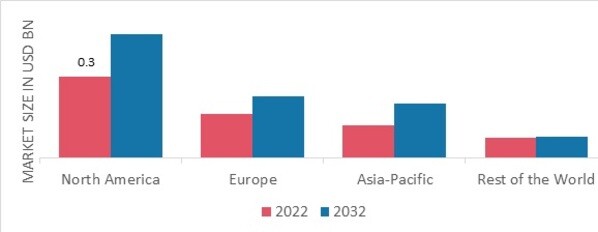Market Trends
Introduction
Whey permeate market is experiencing a major change with the confluence of macro-factors. The development of dairy industry and the advancement of technology are making the permeate production process more efficient and effective. Regulatory pressures are causing the permeate industry to move towards a more sustainable and clean process. And the changing preferences of consumers towards health and well-being are increasing the demand for food and beverage products with health benefits, such as whey permeate. These macro-factors are of strategic importance for market participants, as they are not only influencing product development and innovation, but also affecting the competitive landscape.
Top Trends
-
Increased Demand for Clean Label Products
In the meantime, as consumers are increasingly demanding natural products, manufacturers are increasingly using whey permeate as a natural ingredient. This is a consequence of the fact that 60% of consumers prefer fewer artificial additives. The trend towards more transparency in the supply chain and in the production process also increases brand loyalty. In the future, the trend towards cleaner labelling is likely to be reinforced by stricter labelling regulations. -
Sustainability Initiatives in Dairy Production
In the dairy industry, too, the environment is becoming an important part of the business, and companies such as Arla Foods are introducing sustainable practices. They have learned that 70 per cent of consumers are prepared to pay more for products from sustainable farming. And that means more investment in the development of renewable energy and reduction of waste. Eventually, as sustainability becomes a differentiator, companies will be forced to adopt greener practices to meet consumer expectations. -
Growth in Functional Foods and Beverages
In the case of whey permeate, it is the rise of the ‘functional food’ trend that is driving its use in health-related products. According to data, the ‘functional food’ market is set to grow at a rate of 8 per cent a year. Whey permeate, with its high nutritional profile, can be used to enhance the nutritional profile of these foods. Using this trend, companies are creating new products to meet the needs of health-conscious consumers. In the future, the trend is likely to lead to an increase in research and development into the use of whey permeate in ‘functional’ foods. -
Expansion of E-commerce Channels
The distribution of whey is changing, and the share of e-commerce in the sales of whey is increasing significantly. According to industry reports, e-commerce grocery sales have increased by more than 30% in the past year. Adapting to the situation, companies are enhancing their digital presence and adjusting their supply chains to e-commerce. It is hoped that this trend will lead to a closer relationship with consumers and a more individualized approach to marketing and customer service. -
Innovations in Dairy Processing Technologies
In recent years, the development of milk processing has improved the efficiency of whey permeation. Various companies have invested in modern filtration and separation techniques, which have increased yields by up to twenty per cent. This trend is reducing production costs and improving the quality of the finished products. The next step will probably be the integration of artificial intelligence and automation into the process, which will increase efficiency even further and reduce wastage. -
Rising Popularity of Plant-Based Alternatives
Whey permeate is a dairy alternative. The market for plant-based foods is projected to grow at a rate of 10 per cent a year, which has prompted dairy companies to develop hybrid products. This trend is bringing together the worlds of dairy and plant-based foods to create new products. Whey permeate is one of these products. The future may bring a new generation of formulations that combine whey permeate with plant-based proteins. -
Focus on Nutritional Fortification
The fortification of foodstuffs is becoming a priority. The whey permeate is used to increase the nutritive value of various products. It has been shown by research that fortified foods improve the nutritional status, especially in vulnerable populations. The companies are taking advantage of this trend to develop products that meet a particular need, such as the fortification of food with proteins. In the future, it may be the regulatory framework that encourages the use of fortified products. -
Increased Regulatory Scrutiny
Various food-safety authorities are increasing their scrutiny of the quality and safety of food ingredients, including whey permeate. Recent guidelines emphasize the need for transparency in determining the origin of food ingredients. This is affecting how companies formulate their products. These developments are causing companies to invest in compliance and quality assurance. Eventually, stricter regulations could affect the sourcing of ingredients and the labeling of products. -
Emergence of Personalized Nutrition
Customized nutrition is growing in importance. The whey permeate can be adapted to individual dietary needs. Customized nutrition has been proven to be beneficial for health, thereby creating a demand for custom-made products. Whey permeate companies are therefore exploring the use of data to develop a whey permeate solution that is tailored to individual needs. In the future, it is possible that the technology will develop to such an extent that dietary preferences can be adapted in real time. -
Global Supply Chain Resilience
Despite recent disruptions, supply chain resilience is a focus of attention in the whey permeate market. Companies are diversifying their suppliers and investing in local sourcing to mitigate risks. A survey of companies shows that forty per cent are prioritising a flexible supply chain to help them adapt to market changes. This trend may result in more resilient supply chains that can withstand the most severe disruptions and guarantee stable product availability.
Conclusion: Navigating the Whey Permeate Landscape
The Whey Permeate Market 2024 is characterized by an intense and highly fragmented competition with the presence of a large number of players from the old and new economy. In terms of geography, the demand for whey permeate is growing in North America and Europe, driven by rising health awareness and the growing popularity of high-protein diets. Strategically, vendors should rely on advanced capabilities such as artificial intelligence for predicting the future, automation for achieving operational efficiency and meeting consumer expectations. The importance of product flexibility will also increase with the evolution of consumer preferences. Companies that successfully combine these capabilities will continue to lead, while those that fail to adapt will find it difficult to survive in the changing environment.







Leave a Comment